child lock KIA QUORIS 2013 Owners Manual
[x] Cancel search | Manufacturer: KIA, Model Year: 2013, Model line: QUORIS, Model: KIA QUORIS 2013Pages: 485, PDF Size: 31.55 MB
Page 19 of 485

Safety features of your vehicle
4
3
Front seat adjustment
The front seat can be adjusted by
using the control switch located on
the doors. Before driving, adjust theseat to the proper position so as to
easily control the steering wheel,
pedals and switches on the instru-ment panel.
WARNING
The power seat is operable with
the engine start/stop button in
OFF.
Therefore, children should
never be left unattended in the
vehicle.
WARNING
Do not adjust the seat while wearing seat belts. Moving the
seat cushion forward may
cause strong pressure on theabdomen.
Use extreme caution so that hands or other objects are not
caught in the seat mechanisms
while the seat is moving.
Do not put a cigarette lighter on the floor or seat. When you
operate the seat, gas maygush out of the lighter and
cause fire.(Continued)
Do not allow anything to inter-fere with the normal position of
the seatback. Storing items
against a seatback or in any
other way interfering with prop-
er locking of a seatback could
result in serious or fatal injury
in a sudden stop or collision.
your seatback upright and the
lap portion of the seat belt
snug and low across the hips.This is the best position to
protect you in case of an acci-dent.
In order to avoid unnecessary and perhaps severe air bag
injuries, always sit as far back
as possible from the steeringwheel while maintaining com-
fortable control of the vehicle.
We recommend that your
chest be at least 250 mm (10
inches) away from the steer-ing wheel.
Page 48 of 485
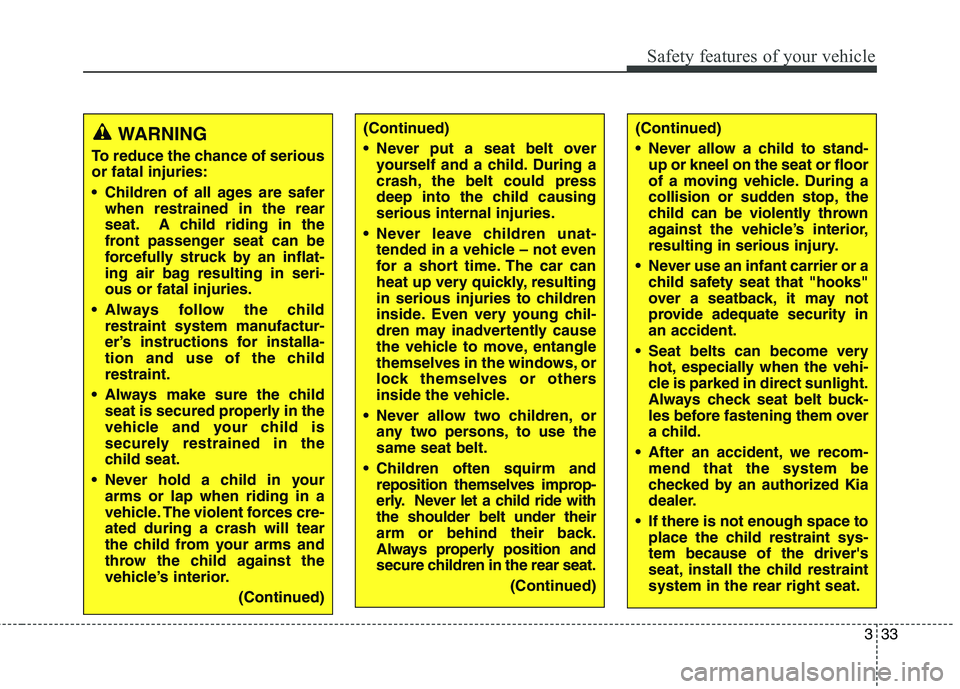
333
Safety features of your vehicle
WARNING
To reduce the chance of serious or fatal injuries:
Children of all ages are safer when restrained in the rear
seat. A child riding in the
front passenger seat can be
forcefully struck by an inflat-
ing air bag resulting in seri-ous or fatal injuries.
Always follow the child restraint system manufactur-
er’s instructions for installa-
tion and use of the childrestraint.
Always make sure the child seat is secured properly in the
vehicle and your child is
securely restrained in the
child seat.
Never hold a child in your arms or lap when riding in a
vehicle. The violent forces cre-ated during a crash will tear
the child from your arms and
throw the child against the
vehicle’s interior.
(Continued)(Continued)
Never put a seat belt overyourself and a child. During a
crash, the belt could press
deep into the child causingserious internal injuries.
Never leave children unat- tended in a vehicle – not even
for a short time. The car can
heat up very quickly, resulting
in serious injuries to children
inside. Even very young chil-
dren may inadvertently cause
the vehicle to move, entangle
themselves in the windows, or
lock themselves or others
inside the vehicle.
Never allow two children, or any two persons, to use thesame seat belt.
Children often squirm and reposition themselves improp-
erly. Never let a child ride withthe shoulder belt under their
arm or behind their back.
Always properly position and
secure children in the rear seat.
(Continued)(Continued)
Never allow a child to stand-up or kneel on the seat or floor
of a moving vehicle. During a
collision or sudden stop, the
child can be violently thrown
against the vehicle’s interior,
resulting in serious injury.
Never use an infant carrier or a child safety seat that "hooks"
over a seatback, it may not
provide adequate security inan accident.
Seat belts can become very hot, especially when the vehi-
cle is parked in direct sunlight.
Always check seat belt buck-
les before fastening them over
a child.
After an accident, we recom- mend that the system be
checked by an authorized Kia
dealer.
If there is not enough space to place the child restraint sys-tem because of the driver's
seat, install the child restraintsystem in the rear right seat.
Page 51 of 485

Safety features of your vehicle
36
3
Installing a child restraint system
by lap/shoulder belt
To install a child restraint system on
the outboard or center rear seats, do
the following:
1. Place the child restraint system in the seat and route the lap/shoul- der belt around or through the
restraint, following the restraint
manufacturer’s instructions. Be
sure the seat belt webbing is nottwisted. 2. Fasten the lap/shoulder belt latch
into the buckle. Listen for the dis-
tinct “click” sound.Position the release button so that it
is easy to access in case of an emer-gency.
3. Buckle the seat belt and allow the seat belt to take up any slack. After
installation of the child restraint
system, try to move it in all direc-
tions to be sure the child restraintsystem is securely installed.
If you need to tighten the belt, pull
more webbing toward the retractor.
When you unbuckle the seat belt and
allow it to retract, the retractor will
automatically revert back to its nor-mal seated passenger emergency
locking usage condition.
OEN036101
E2MS103005
OEN036104
Page 61 of 485
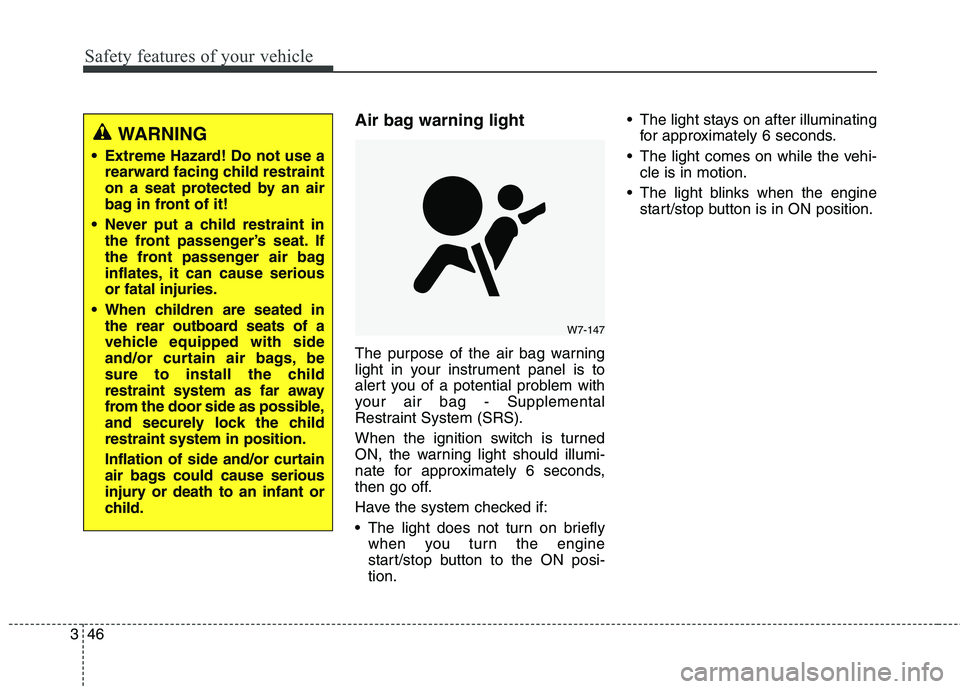
Safety features of your vehicle
46
3
Air bag warning light
The purpose of the air bag warning
light in your instrument panel is to
alert you of a potential problem with
your air bag - Supplemental
Restraint System (SRS).
When the ignition switch is turned
ON, the warning light should illumi-
nate for approximately 6 seconds,
then go off.
Have the system checked if:
The light does not turn on briefly
when you turn the engine
start/stop button to the ON posi-tion. The light stays on after illuminating
for approximately 6 seconds.
The light comes on while the vehi- cle is in motion.
The light blinks when the engine start/stop button is in ON position.WARNING
Extreme Hazard! Do not use a rearward facing child restraint
on a seat protected by an air
bag in front of it!
Never put a child restraint in the front passenger’s seat. If
the front passenger air bag
inflates, it can cause serious
or fatal injuries.
When children are seated in the rear outboard seats of a
vehicle equipped with side
and/or curtain air bags, be
sure to install the child
restraint system as far away
from the door side as possible,
and securely lock the childrestraint system in position.
Inflation of side and/or curtain
air bags could cause serious
injury or death to an infant or
child.
W7-147
Page 71 of 485
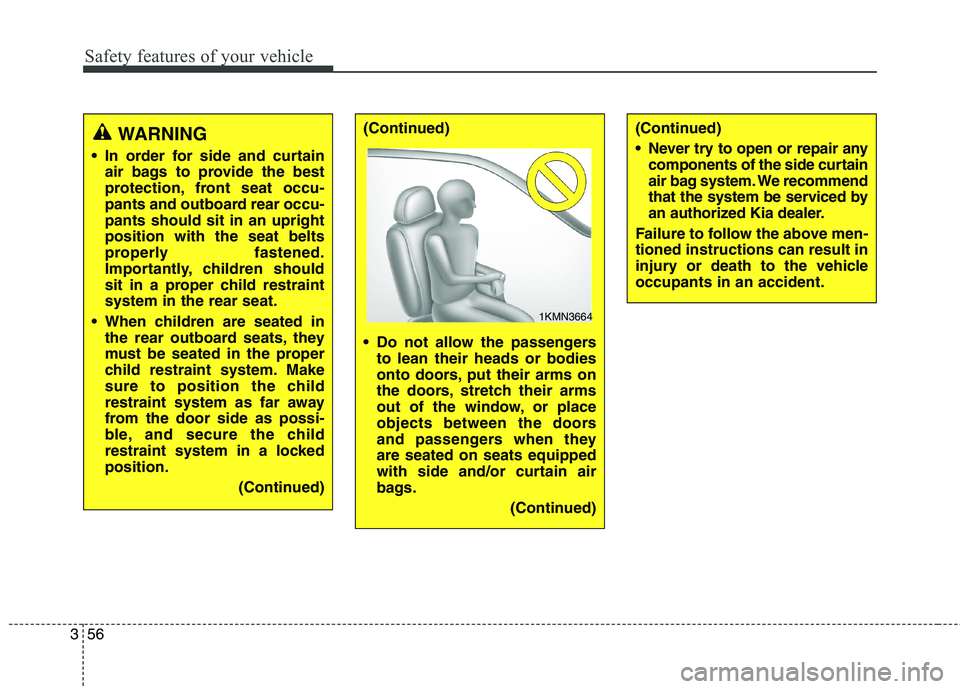
Safety features of your vehicle
56
3
WARNING
In order for side and curtain air bags to provide the best
protection, front seat occu-
pants and outboard rear occu-pants should sit in an uprightposition with the seat belts
properly fastened.
Importantly, children should
sit in a proper child restraintsystem in the rear seat.
When children are seated in the rear outboard seats, they
must be seated in the proper
child restraint system. Make
sure to position the child
restraint system as far away
from the door side as possi-
ble, and secure the child
restraint system in a lockedposition.
(Continued)(Continued)
Do not allow the passengersto lean their heads or bodies
onto doors, put their arms on
the doors, stretch their arms
out of the window, or place
objects between the doors
and passengers when theyare seated on seats equipped
with side and/or curtain air
bags.
(Continued)(Continued)
Never try to open or repair anycomponents of the side curtain
air bag system. We recommend
that the system be serviced by
an authorized Kia dealer.
Failure to follow the above men-tioned instructions can result in
injury or death to the vehicleoccupants in an accident.
1KMN3664
Page 97 of 485

Features of your vehicle
18
4
Door lock/unlock features
Impact sensing door unlock sys-
tem
All doors will automatically unlock when an impact causes the air bags
to deploy.
Speed sensing door lock system
All doors will automatically lock after
the vehicle speed exceeds 15 km/h.
WARNING - Unlocked
vehicles
Leaving your vehicle unlocked
can invite theft or possible harm
to you or others from someone
hiding in your vehicle while you
are gone. Always remove the
ignition key, engage the parking
brake, close all windows and
lock all doors when leaving
your vehicle unattended.
WARNING - Unattended
children
An enclosed vehicle can
become extremely hot, causing
death or severe injury to unat-
tended children or animals who
cannot escape the vehicle.
Furthermore, children might
operate features of the vehicle
that could injure them, or theycould encounter other harm,
possibly from someone gaining
entry to the vehicle. Never leave
children or animals unattended
in your vehicle.
WARNING - Doors
The doors should always be fully closed and locked while
the vehicle is in motion to pre-vent accidental opening of the
door. Locked doors will also
discourage potential intruders
when the vehicle stops or
slows.
Be careful when opening doors and watch for vehicles,
motorcycles, bicycles or
pedestrians approaching the
vehicle in the path of the door.Opening a door when some-
thing is approaching can
cause damage or injury.
Page 98 of 485

419
Features of your vehicle
Engine off door unlock system
All doors will automatically unlock
when the engine start/stop button is
turned to the ACC or OFF position.
Shift lever door lock/unlock sys-tem
All doors will automatically lock when the shift lever is moved out of
P (Park).
All doors will automatically unlock when the shift lever is moved into P
(Park).
You can activate or deactivate the
auto door lock/unlock features in the
vehicle. Refer to "LCD display" in thissection. Child-protector rear door lock
The child safety lock is provided to
help prevent children from accidental-ly opening the rear doors from inside
the vehicle. The rear door safety locks
should be used whenever children
are in the vehicle.
1. Open the rear door.
2. Push the child safety lock (1) to
the lock ( ) position. When the
child safety lock is in the lock posi-tion, the rear door will not open
even though the inner door handleis pulled. 3. Close the rear door.
To open the rear door, pull the out-
side door handle.
Even though the doors may be
unlocked, the rear door will not open
by pulling the inner door handle (2)
until the rear door child safety lock is
unlocked.
WARNING
- Rear door
locks
If children accidentally open the
rear doors while the vehicle is
in motion, they could fall out
and be severely injured or
killed. To prevent children from
opening the rear doors from the
inside, the rear door safety
locks should be used whenever
children are in the vehicle.
OKH042015
Page 101 of 485
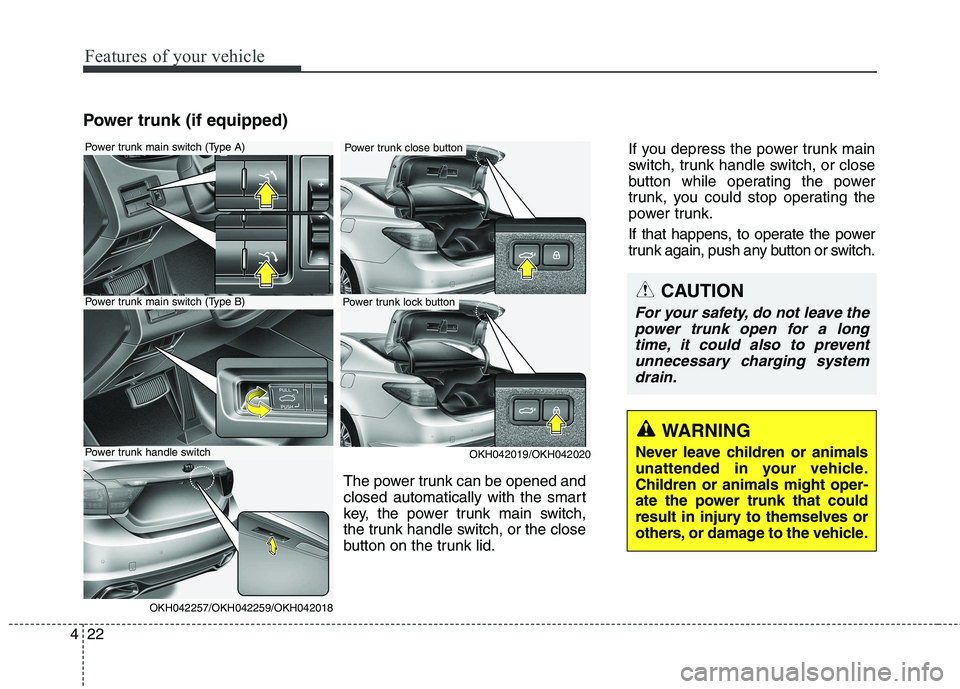
Features of your vehicle
22
4
WARNING
Never leave children or animals
unattended in your vehicle.Children or animals might oper-
ate the power trunk that could
result in injury to themselves or
others, or damage to the vehicle.
Power trunk (if equipped)
OKH042019/OKH042020
Power trunk main switch (Type A)
Power trunk main switch (Type B)
OKH042257/OKH042259/OKH042018
Power trunk handle switch
Power trunk lock button
Power trunk close button If you depress the power trunk main
switch, trunk handle switch, or close
button while operating the power
trunk, you could stop operating the
power trunk.
If that happens, to operate the power
trunk again, push any button or switch.
The power trunk can be opened and
closed automatically with the smart
key, the power trunk main switch,
the trunk handle switch, or the close
button on the trunk lid.
CAUTION
For your safety, do not leave the power trunk open for a longtime, it could also to preventunnecessary charging system drain.
Page 110 of 485
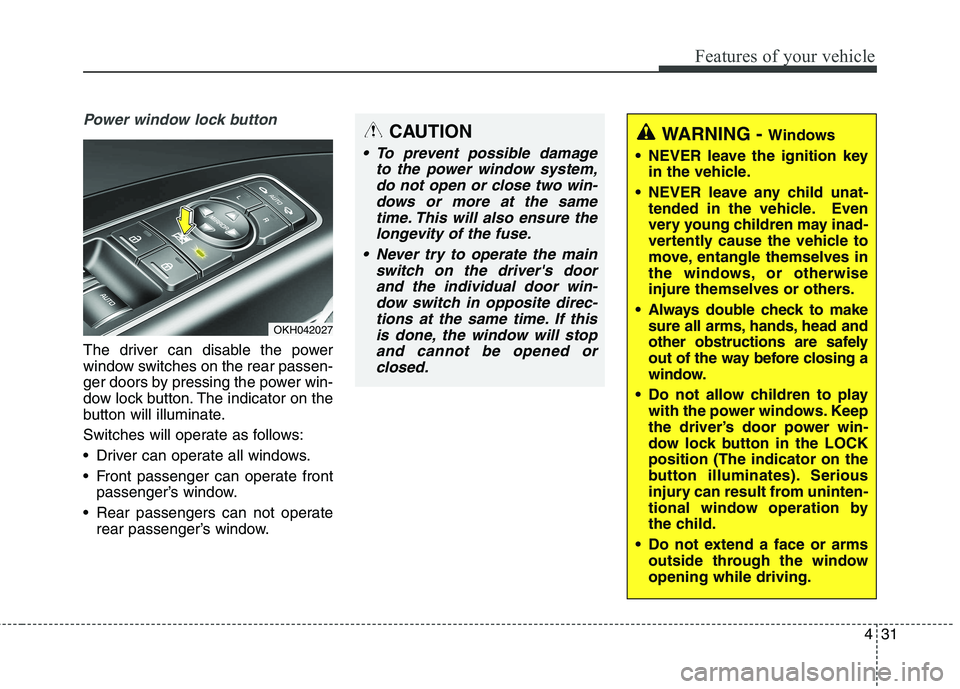
431
Features of your vehicle
Power window lock button
The driver can disable the power
window switches on the rear passen-
ger doors by pressing the power win-
dow lock button. The indicator on the
button will illuminate.
Switches will operate as follows:
Driver can operate all windows.
Front passenger can operate frontpassenger’s window.
Rear passengers can not operate rear passenger’s window.
OKH042027
CAUTION
To prevent possible damage
to the power window system,do not open or close two win-dows or more at the sametime. This will also ensure the longevity of the fuse.
Never try to operate the main switch on the driver's doorand the individual door win-dow switch in opposite direc- tions at the same time. If thisis done, the window will stopand cannot be opened orclosed.
WARNING - Windows
NEVER leave the ignition key in the vehicle.
NEVER leave any child unat- tended in the vehicle. Even
very young children may inad-
vertently cause the vehicle to
move, entangle themselves in
the windows, or otherwise
injure themselves or others.
Always double check to make sure all arms, hands, head and
other obstructions are safely
out of the way before closing a
window.
Do not allow children to play with the power windows. Keep
the driver’s door power win-
dow lock button in the LOCKposition (The indicator on the
button illuminates). Serious
injury can result from uninten-
tional window operation by
the child.
Do not extend a face or arms outside through the windowopening while driving.
Page 256 of 485

513
Driving your vehicle
For smooth operation, depress thebrake pedal when shifting from N(Neutral) to a forward or reverse gear.Transmission ranges
The indicator in the instrument clus-
ter displays the shift lever position
when the ignition switch is in the ONposition.
P (Park)
Always come to a complete stop
before shifting into P (Park). This
position locks the transmission and
prevents the drive wheels from rotat-ing.
WARNING - Automatic
transmis- sion
Always check the surrounding areas near your vehicle for
people, especially children,
before shifting a car into D
(Drive) or R (Reverse).
Before leaving the driver’s seat, always make sure the
shift lever is in the P (Park)
position; then set the parking
brake fully and shut the
engine off. Unexpected and
sudden vehicle movementcan occur if these precautions
are not followed in the orderidentified.
CAUTION
To avoid damage to your
transmission, do not acceler-ate the engine in R (Reverse) or any forward gear positionwith the brakes on.
When stopped on an incline, do not hold the vehicle sta-tionary with engine power. Use the service brake or theparking brake.
Do not shift from N (Neutral) or P (Park) into D (Drive), or R(Reverse) when the engine is above idle speed.
WARNING
Shifting into P (Park) while the vehicle is in motion will cause
the drive wheels to lock which
will cause you to lose control
of the vehicle.
Do not use the P (Park) posi- tion in place of the parking
brake. Always make sure the
shift lever is latched in the P
(Park) position and set the
parking brake fully.
Never leave a child unattend- ed in a vehicle.